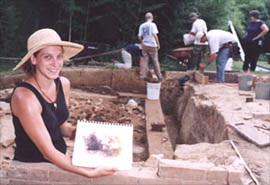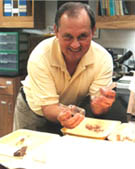UA Archaeologists Unearth Early Tabasco Home
by Chris Bryant

It was hard to know which was hotter, the pepper sauce, the sweltering Louisiana temperatures or the secrets being unearthed.
For the second consecutive summer, a University of Alabama-led archaeological team excavated portions of the original factory site on Avery Island, La., where Tabasco brand pepper sauce was first produced in the mid- to late 1860s.
The crew made several interesting discoveries during its latest six-week dig, including the unearthing of what may be the earliest known Tabasco bottles and the exposure of more than 22 meters of the buildings’ foundation wall, likely constructed by Confederate soldiers in 1862.
McIlhenny Company, makers of Tabasco sauce, and Avery Island Inc. sponsored the excavation, led by the Gulf Coast Survey of the Alabama Museum of Natural History at UA. Ashley Dumas, a UA graduate student, was the project’s field director while Dr. Ian Brown, a UA professor of anthropology, is the principal investigator.
Dumas said the product — and the site that once produced it — could model other products and businesses that blossomed during the Industrial Age.
“It’s of national significance because it’s the original production site of a product that was really important in the history of the American rural cottage industry,” she said.
The zingy pepper sauce rapidly grew from cottage industry status, and it is now sold in more than 100 countries around the world. Astronauts in space, excavators of King Tut’s tomb, and even Army generals have said they regularly dribble the condiment on various foods.
While the sauce’s distribution has skyrocketed, numerous ties to its beginnings remain. Paul C. P. McIlhenny, president of McIlhenny Company, is the great-grandson of the sauce’s inventor, Edmund McIlhenny, who began producing the sauce commercially in 1868 at the site of this summer’s excavation.

Brown has his own history with the company. In the late 1970s, while employed by the Peabody Museum at Harvard University, Brown and his wife, Nancy — who were newlyweds at the time — became acquainted with the Avery and McIlhenny families, while doing other excavation work on Avery Island.
“In a way, we were adopted by their family,” Brown said. The bonds were strong as the Browns attended family reunions, frequently as the only invited nonfamily members. “We’ve always enjoyed being a part of that because it’s such a special family.” The link was so special the Browns even named their daughter Avery.
So, when the McIlhenny and Avery families decided a few years ago to resume archaeological research at the factory, they contacted Brown for advice. He jumped at the chance.
“It’s been wonderful to experience this because, in a way, Avery Island is home to me and my wife too. It’s nice to be able to help them reconstruct their own history and prehistory.”
Dr. Shane K. Bernard, historian and curator for the companies, conceived the excavations and serves as the official liaison between the sponsoring corporations and the UA-led team.
The initial project, led by Brown during summer 2000, identified the exact site of the historic building, known as the Laboratory, which was torn down in the 1920s. During the most recent dig, the student excavators also discovered a set of stairs leading to a basement-level doorway and partially excavated a trash pile that contained at least 10 complete or near-complete 19th-century Tabasco bottles. Several intact cork-top Tabasco bottles were found buried on the archaeological site, including a few of unusual design that may be the earliest known Tabasco bottles.
The crew, using archival photographs, also identified three complete six- and eight-gallon stoneware jars used in early Tabasco production, as well as a large, intact glass container known as a demijohn. This container once held vinegar used in early sauce production, Bernard said. Other artifacts uncovered included fossils from giant extinct mammals, presumably from the natural history collection that Tabasco inventor E. McIlhenny kept in the factory.
UA students Wes Shaw, Miranda Moore, Duane Strelow and Ryan Bays worked with Dumas during this past season. Three students from the University of Louisiana at Lafayette and one student from Northwestern State University of Louisiana also participated.
Company representatives have expressed an interest in UA possibly continuing excavation work on the site next year. Brown said the area surrounding where the factory stood, known as Homestead Hill, likely has its own secrets to reveal.
“I think it could give a good picture of what was happening in plantation life and post-plantation life, in general. The beauty of Avery Island is that it’s been protected and the hill has not changed much over time.”
Contact
Linda Hill, UA Media Relations, 205/348-8325, lhill@ur.ua.edu
Source
Kayte Campbell, UA Campus Programs, Upgrad1@sa.ua.edu